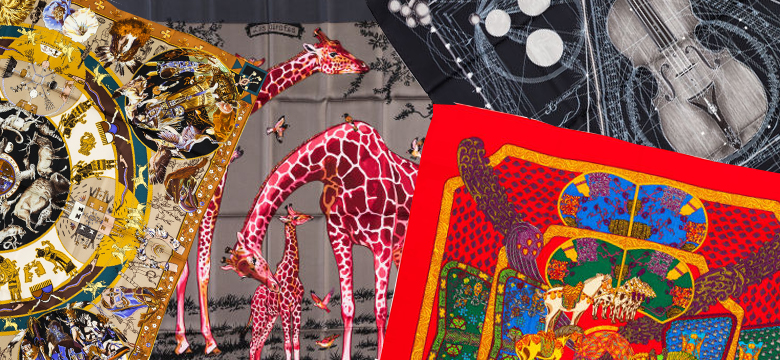
My love affair with scarves began at the age of eleven when I inherited my grandmother’s collection. The rest of her clothes were given to charity when she died, but her scarves seemed too full of memory to let go – the many times had I seen her drape her shoulders or tie a knot under her chin to protect her set curls from the elements. At the time, I was under the impression that scarves were acceptable only for winter or little old ladies (preferably smelling of Chanel no. 5). As I matured, however, I began to integrate them into my wardrobe, and they always received compliments. My peers were shocked (shocked, I tell you!) to discover these little beauties were a legacy from my grandmother. One of the most regrettable symptoms of youth is the tendency to typify anything old as ‘unfashionable’.
Over the years, my collection has grown until it now comprises a sizable portion of my closet. The pride of my collection are the Hermès scarves or carrés. There’s something uniquely alluring about an Hermès scarf : the fluidity of color and design, the drape of the silk. At the moment, scarves seem to be making a huge fashion comeback, but in reality, they never left. Cast you memory back ten years to 2004. Remember Miranda Priestly? The ultra-chic, uber-villain from Lauren Weisberger’s The Devil Wears Prada? She was notorious for incorporating a white Hermès scarf into her daily ensemble. (Ultimately, this isn’t enough to mitigate her causticity, but it sure made me like her better.) Go back another decade to 1992 where an Hermès scarf made a cameo appearance in Basic Instinct. The perfect accessory in the right hands.
So, what makes the Hermès carré so special? These delicate silk canvases practically speak for themselves in terms of beauty. Each 90cm x 90cm carré is woven from the finest quality silk and painstakingly created by hand at every stage of production from the Hermès workshops in France. In the 77 years that Hermès has been designing and crafting these scarves, they’ve refused to cut corners where quality is concerned. Each scarf is individually screen-printed, one color at a time. After printing, the carré is finished with a hand-stitched hem. Check out the screen-printing process illustrated in this Hermès video: How Hermès silk scarves are made. In terms of craftsmanship, I quote Carly Simon, “nobody does it better.”
Hermès designers spend upwards of two years planning and executing each Season’s line of female neck-ware. The designs themselves can be whimsical, often atypical, but always breathtaking. Hermès produces two collections every year in addition to reprinting a number of popular vintage designs. Equestrian themes are a signature motif found in carré designs, such as the popular A Cheval sur Mon Carre or Courses a Chantilly. Like the Hermès horse and Duc carriage label itself, these horsey motifs are a nod to the origins of the Hermès empire, which began in the 1800s as harness and bridle makers to the great houses of Europe. The rare Hermès Bicycle now offered at auction on December 8th embodies this sporty side that has always been at the heart of their luxury goods.
While honoring the past, Hermès has certainly moved with the times. Imagine my inexpressible joy at discovering a new favorite iPhone app: Hermès Silk Knots. Like everything from Hermès, the app is beautifully designed, not only displaying the current Season’s collection, but providing step-by-step images and video tutorials for 24 different ways to tie the carré, ranging from classic knots to fashion-forward belts, blouses, and even dresses. But don’t consider these knots exhaustive; they’re more like guidelines, a place to start. In France, an entire subculture exists surrounding the mystique of the scarf and the limitless ways it can be worn. Even the language speaks to this obsession. Écharpe, foulard, fishu, entaille, enture, cache-col, châle: all synonyms for ‘scarf’.
The possibilities are only limited by one’s imagination. The Hermès carré is not the nostalgic standby of little old ladies, but such stuff as a modern girl’s dreams are made of. And each collector has a special motivation. For example, I’m acquainted with a mother and daughter who add a scarf to their respective collections to commemorate a journey: an eastern-themed scarf for a visit to India, a tropical-themed scarf for an island holiday. Instead of picture postcards or kitschy souvenirs, they imbue these scarves with the memories made on these journeys, and can relive those memories any time they tie that silk knot.
Myself, I collect Hermès scarves for obvious reasons: they are beautiful, versatile accessories – miniature works of art. But they are not the type of art kept in vaults to appreciate value. The art of Hermès actually sees the light of day: a wearable collection.
By Holly Culbreath


Leave a Comment